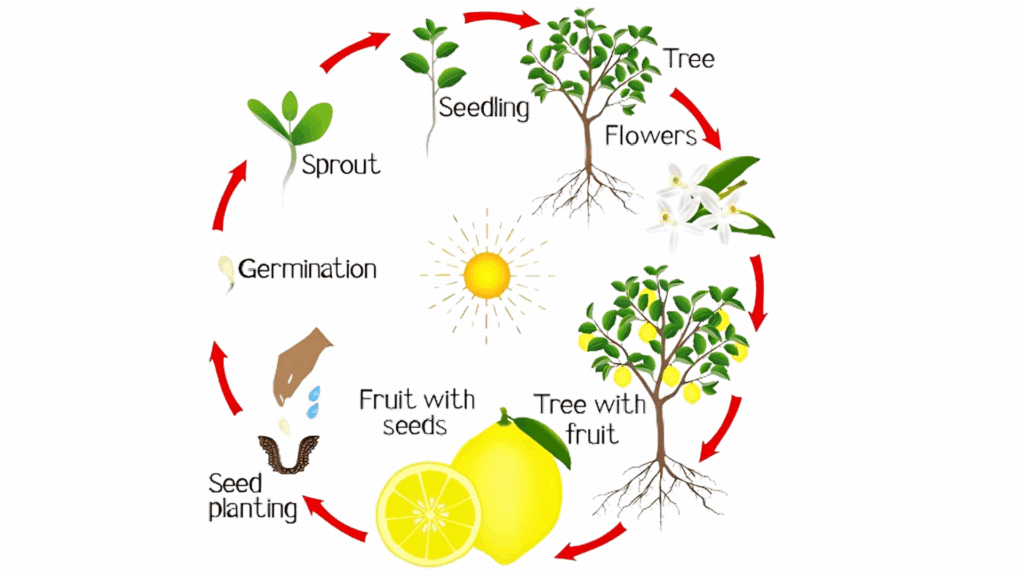Growing a lemon tree from seed to fruit can feel overwhelming for many gardeners. They often wonder when their tiny seedling will finally produce those bright yellow lemons they’re hoping for.
The waiting game gets frustrating, especially when progress seems slow.
This follows predictable lemon tree growth stages, and knowing what to expect helps gardeners care for their trees properly.
This blog will walk you through all the major growth phases of lemon trees.
Life Stages of a Lemon Tree

A lemon tree goes through several stages in its life, from a tiny seed to a full-grown tree bursting with fruit. Each phase is unique and helps the tree grow strong. Here are all the lemon tree growth stages
1. Seed Germination
The lemon tree’s journey begins with a seed. Germination occurs when a seed is placed in moist soil and kept at a warm temperature.
For 1–2 weeks, the seed coat softens, allowing the tiny sprout inside to emerge and grow. First, roots push downward to find water, then a small green shoot reaches for light. This is called the seedling.
At this point, the plant begins producing food through the process of photosynthesis, utilizing sunlight. Good drainage and regular moisture are key for successful germination.
Without the right warmth, water, and light, germination can fail, so conditions matter a lot in this early stage.
2. Seedling Stage
This is one stage of growth for a lemon tree that follows germination. The seedling grows tiny leaves called cotyledons that help it make food.
Over time, it produces true leaves that look like lemon tree leaves. The stem thickens, and roots spread deeper into the soil. It’s important to water regularly, but not too much. This stage lasts a few months.
Young plants are sensitive, so protect them from harsh sun, pests, and strong winds. During this stage:
- Sunlight should be indirect but steady
- Soil should stay damp but never soggy
- Fertilizer can help growth, but only in small amounts
3. Juvenile Stage
The juvenile stage is one of the primary growth stages of the lemon tree. The lemon tree appears as a small tree, but doesn’t produce flowers or fruit yet. It focuses on growing taller, stronger, and fuller.
Branches begin to form, and the root system expands widely underground. This stage can last 2 to 5 years, depending on care and variety. Though it doesn’t bear fruit, this stage is vital for building future strength.
It’s a good time to prune the tree to shape it. The tree also needs:
- Full sun (about 8 hours a day)
- Balanced watering
- Occasional feeding with citrus-friendly fertilizer
4. Flowering Stage
Once mature, the lemon tree begins to produce small, white, fragrant flowers.
This is a sign that the tree is healthy and ready for fruit. Flowers can grow singly or in small clusters. They attract bees and other pollinators, which help move pollen between flowers. That’s how fertilization happens.
The flower has several parts:
- Petals: white and soft
- Pistil and stamen: where pollination occurs
Some flowers may fall off early, which is normal. Weather, water levels, and nutrients affect how many flowers bloom. This stage is key for future lemons to grow.
5. Fruiting Stage
After successful pollination, flowers turn into small green fruits. Over several months, these fruits grow into bright yellow lemons.
The tree now requires extra care, as producing fruit requires a significant amount of energy.
It’s important to:
- Keep watering evenly
- Add compost or fertilizer every few weeks
- Protect from pests like aphids or fruit flies
Lemons mature in 6 to 9 months. Once they’re bright yellow and slightly soft, they’re ready to pick. Some trees fruit twice a year. This stage is exciting because the tree finally rewards you with fresh lemons.
6. Maturity and Decline
After years of healthy fruiting, lemon trees begin to slow down. Leaves may yellow, and fewer lemons grow. This is the aging phase.
The tree can still live for many years with care. Pruning dead branches and feeding the soil can extend its life. Older trees may develop bark cracks or reduced flowering.
Signs of aging include:
- Thinner canopy
- Fewer or smaller fruits
- More vulnerability to disease
Although fruiting may decline, mature lemon trees still offer shade, beauty, and sometimes flowers. Proper care can help them stay productive and healthy longer.
Lemon Tree Pests and Natural Solutions
Every gardener meets a few tiny troublemakers along the way. Lemon trees are no exception.
Here’s how to identify common pests and treat them gently yet effectively.
| Pest | Damage | Natural Solution |
|---|---|---|
| Aphids | Curling leaves, sticky residue | Neem oil, ladybugs, mild soap spray |
| Spider Mites | Yellow spots, fine webbing | Water spray, insecticidal soap and increase humidity |
| Leaf Miners | White squiggly lines on leaves | Prune damaged leaves, neem oil and sticky traps |
| Whiteflies | Sap loss, weak growth | Yellow sticky traps, garlic spray, lacewings |
| Scale Insects | Bumps on stems, sooty mold | Alcohol swab, horticultural oil |
Lesser-Known Facts About Lemon Trees
Now you understand all the lemon tree growth stages. Here are some lesser-known facts that emphasize the quirky aspects of lemon trees.
- Some lemon trees can live for over 100 years with proper care.
- Lemons are technically a hybrid between bitter orange and citron.
- The blossoms of lemon trees are edible and have a mildly fragrant scent.
- A single lemon tree can yield up to 600 pounds of lemons a year.
- Lemon trees can grow fruit and flowers at the same time.
- The leaves of a lemon tree can be used for tea or cooking.
- In ancient times, lemons were used to treat scurvy on long sea voyages.
Final Thoughts
Understanding the lemon tree growth stages , from seed germination to fruiting, provides a clear insight into how nature changes something so small into something amazing.
Each phase plays a role in helping the tree grow stronger, bear fruit, and even rest for future seasons.
If you’re a student, gardener, or curious learner, knowing these stages helps you appreciate the patience and care a lemon tree needs.
And if you’re growing one yourself, this guide gives you the confidence to support your tree at every step. Remember, growth doesn’t happen overnight, but with time and care, lemons will bloom.




